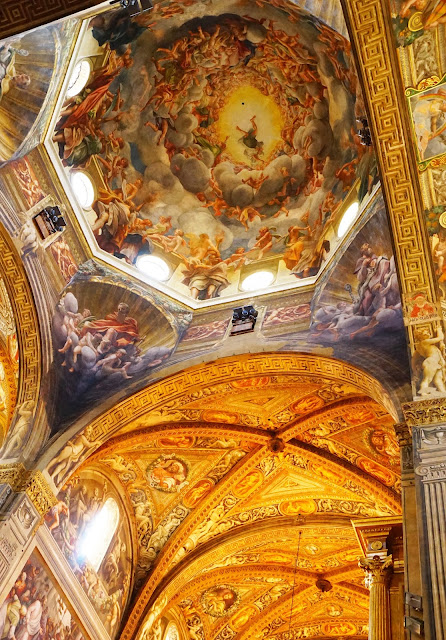Along the way, we stop at the performance hall named after Luciano Pavarotti - just a little gesture to pay homage to the singer. Store window displays in town let you know that you are in the balsamic vinegar land. We also notice the sign: "Discover Land of Ferrari and Pavarotti." The interior of the Cathedral is a delight to behold. No visible damages in the city center from the 2012 earthquakes to the casual observer.
 |
| Modena: Teatro Comunale Luciano Pavarotti |
 |
| Modena: a catchy slogan seen all over town |
 |
| Modena: ubiquitous balsamic vinegar, which are classified according to strict criteria including the age |
 |
| Modena: the Cathedral complex with the bell tower and the square are on the UNESCO World Heritage list. |
 |
| Modena: the Cathedral is an important Romanesque structure but also has an eclectic style |
 |
| Modena Cathedral: the tomb of San Gimignano, the patron saint of this city who may be better known by the medieval city near Florence that bears his name |
At the restaurant, the decor is minimalist but the culinary experience is maximal. No gimmicks but just superior creativity and perfect execution. A number of memorable dishes in the combination of the two menus we chose - traditional and experimental. When the chef comes out to say hello, the person at the next table says he's read the chef's book, "Never trust a skinny Italian chef," which propels them on a long exchange. When the chef makes it to our table, I feel that I have nothing substantive to say and instead the wife does most of the talking, which is unusual. He states to the effect that cooking a tasty and pretty meal is the easy part but he is trying to elevate food to another level so it can represent culture. Not sure exactly what that means but we are glad we got to meet him.
 |
| Osteria Francescana, Modena: some things aren't what they seem - "Crab and Corn" |
 |
| Osteria Francescana: parmesan cheeses of 5 different ages, texture and temperature |
 |
| Osteria Francescana: This presentation, with "psychedelic" somewhere in the description, is inspired by a Damian Hirst painting hanging at the entrance. |
 |
| Osteria Francescana: normally I have to be force fed lettuce but I could eat this concoction every meal, voluntarily. |
 |
| Osteria Francescana: These petits fours are a giant success. |
On the way back to Milan, we stop at Parma. At the train station we do not find a taxi so decide to walk. Interestingly in all the small cities we visited on this trip, the train station seems to be located 1 - 1.5km from the center, an easy walking distance by European standards and also nothing to us, the veterans of Camino de Santiago! Parma may be best known for its prosciutto and Parmesean cheese (or Parmigiano-Reggiano, the protected designation of origin by EU), but also boasts a fine duomo and baptistry.
 |
| Parma: the Duomo and the Bell Tower |
 |
| Parma: drop two coins and the beautiful vault over the nave and the frescoes are illuminated. |
 |
| Parma: the most treasured work inside the Duomo is the illusionist painting in the cupola by Coreggio. And that would be another 2 Euros for illumination. |
 |
| Parma: this Baptistery almost overshadows the Duomo next door. The construction began in late 12th Century but was interrupted when the supply of pink Verona marble ran out. |
 |
| Baptistry, Parma: they let us in 5 minutes before closing (and at no charge) to see the excellent interior. |
No comments:
Post a Comment